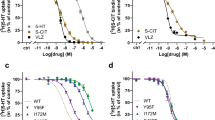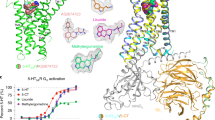Abstract
Selective serotonin reuptake inhibitors are clinically prescribed antidepressants that act by increasing the local concentrations of neurotransmitters at synapses and in extracellular spaces via blockade of the serotonin transporter. Here we report X-ray structures of engineered thermostable variants of the human serotonin transporter bound to the antidepressants sertraline, fluvoxamine, and paroxetine. The drugs prevent serotonin binding by occupying the central substrate-binding site and stabilizing the transporter in an outward-open conformation. These structures explain how residues within the central site orchestrate binding of chemically diverse inhibitors and mediate transporter drug selectivity.
This is a preview of subscription content, access via your institution
Access options
Access Nature and 54 other Nature Portfolio journals
Get Nature+, our best-value online-access subscription
$29.99 / 30 days
cancel any time
Subscribe to this journal
Receive 12 print issues and online access
$189.00 per year
only $15.75 per issue
Buy this article
- Purchase on Springer Link
- Instant access to full article PDF
Prices may be subject to local taxes which are calculated during checkout




Similar content being viewed by others
References
Kristensen, A. S. et al. SLC6 neurotransmitter transporters: structure, function, and regulation. Pharmacol. Rev. 63, 585–640 (2011).
Berger, M., Gray, J. A. & Roth, B. L. The expanded biology of serotonin. Annu. Rev. Med. 60, 355–366 (2009).
Hahn, M. K. & Blakely, R. D. The functional impact of SLC6 transporter genetic variation. Annu. Rev. Pharmacol. Toxicol. 47, 401–441 (2007).
Watts, S. W., Morrison, S. F., Davis, R. P. & Barman, S. M. Serotonin and blood pressure regulation. Pharmacol. Rev. 64, 359–388 (2012).
Brenner, B. et al. Plasma serotonin levels and the platelet serotonin transporter. J. Neurochem. 102, 206–215 (2007).
Bröer, S. & Gether, U. The solute carrier 6 family of transporters. Br. J. Pharmacol. 167, 256–278 (2012).
Rudnick, G. Ion-coupled neurotransmitter transport: thermodynamic vs. kinetic determinations of stoichiometry. Methods Enzymol. 296, 233–247 (1998).
Penmatsa, A., Wang, K. H. & Gouaux, E. X-ray structure of dopamine transporter elucidates antidepressant mechanism. Nature 503, 85–90 (2013).
Coleman, J. A., Green, E. M. & Gouaux, E. X-ray structures and mechanism of the human serotonin transporter. Nature 532, 334–339 (2016).
Yamashita, A., Singh, S. K., Kawate, T., Jin, Y. & Gouaux, E. Crystal structure of a bacterial homologue of Na+/Cl–-dependent neurotransmitter transporters. Nature 437, 215–223 (2005).
Singh, S. K., Piscitelli, C. L., Yamashita, A. & Gouaux, E. A competitive inhibitor traps LeuT in an open-to-out conformation. Science 322, 1655–1661 (2008).
Wennogle, L. P. & Meyerson, L. R. Serotonin modulates the dissociation of [3H]imipramine from human platelet recognition sites. Eur. J. Pharmacol. 86, 303–307 (1982).
Chen, F. et al. Characterization of an allosteric citalopram-binding site at the serotonin transporter. J. Neurochem. 92, 21–28 (2005).
Plenge, P. et al. Steric hindrance mutagenesis in the conserved extracellular vestibule impedes allosteric binding of antidepressants to the serotonin transporter. J. Biol. Chem. 287, 39316–39326 (2012).
Kahlig, K. M. et al. Amphetamine induces dopamine efflux through a dopamine transporter channel. Proc. Natl. Acad. Sci. USA 102, 3495–3500 (2005).
Ramamoorthy, S. et al. Antidepressant- and cocaine-sensitive human serotonin transporter: molecular cloning, expression, and chromosomal localization. Proc. Natl. Acad. Sci. USA 90, 2542–2546 (1993).
Andersen, J., Kristensen, A. S., Bang-Andersen, B. & Strømgaard, K. Recent advances in the understanding of the interaction of antidepressant drugs with serotonin and norepinephrine transporters. Chem. Commun. (Camb.) 25, 3677–3692 (2009).
Mojtabai, R. & Olfson, M. Proportion of antidepressants prescribed without a psychiatric diagnosis is growing. Health Aff. (Millwood) 30, 1434–1442 (2011).
Vetulani, J. & Nalepa, I. Antidepressants: past, present and future. Eur. J. Pharmacol. 405, 351–363 (2000).
Green, E. M., Coleman, J. A. & Gouaux, E. Thermostabilization of the human serotonin transporter in an antidepressant-bound conformation. PLoS One 10, e0145688 (2015).
Coleman, J. A., Green, E. M. & Gouaux, E. Thermostabilization, expression, purification, and crystallization of the human serotonin transporter bound to S-citalopram. J. Vis. Exp. https://doi.org/10.3791/54792 (2016).
Davis, B. A., Nagarajan, A., Forrest, L. R. & Singh, S. K. Mechanism of paroxetine (Paxil) inhibition of the serotonin transporter. Sci. Rep. 6, 23789 (2016).
Andersen, J. et al. Molecular determinants for selective recognition of antidepressants in the human serotonin and norepinephrine transporters. Proc. Natl. Acad. Sci. USA 108, 12137–12142 (2011).
Wang, H. et al. Structural basis for action by diverse antidepressants on biogenic amine transporters. Nature 503, 141–145 (2013).
Zhou, Z. et al. Antidepressant specificity of serotonin transporter suggested by three LeuT–SSRI structures. Nat. Struct. Mol. Biol. 16, 652–657 (2009).
Andersen, J. et al. Mutational mapping and modeling of the binding site for (S)-citalopram in the human serotonin transporter. J. Biol. Chem. 285, 2051–2063 (2010).
Gabrielsen, M. et al. Molecular mechanism of serotonin transporter inhibition elucidated by a new flexible docking protocol. Eur. J. Med. Chem. 47, 24–37 (2012).
Grouleff, J., Ladefoged, L. K., Koldsø, H. & Schiøtt, B. Monoamine transporters: insights from molecular dynamics simulations. Front. Pharmacol. 6, 235 (2015).
Koldsø, H., Grouleff, J. & Schiøtt, B. Insights to ligand binding to the monoamine transporters-from homology modeling to LeuBAT and dDAT. Front. Pharmacol. 6, 208 (2015).
Andersen, J. et al. Molecular basis for selective serotonin reuptake inhibition by the antidepressant agent fluoxetine (Prozac). Mol. Pharmacol. 85, 703–714 (2014).
Tavoulari, S., Forrest, L. R. & Rudnick, G. Fluoxetine (Prozac) binding to serotonin transporter is modulated by chloride and conformational changes. J. Neurosci. 29, 9635–9643 (2009).
Koban, F. et al. A salt bridge linking the first intracellular loop with the C terminus facilitates the folding of the serotonin transporter. J. Biol. Chem. 290, 13263–13278 (2015).
Sucic, S. et al. Switching the clientele: a lysine residing in the C terminus of the serotonin transporter specifies its preference for the coat protein complex II component SEC24C. J. Biol. Chem. 288, 5330–5341 (2013).
Liebschner, D. et al. Polder maps: improving OMIT maps by excluding bulk solvent. Acta Crystallogr. D Struct. Biol. 73, 148–157 (2017).
Rannversson, H., Andersen, J., Bang-Andersen, B. & Strømgaard, K. Mapping the binding site for escitalopram and paroxetine in the human serotonin transporter using genetically encoded photo-cross-linkers. ACS Chem. Biol. 12, 2558–2562 (2017).
Henry, L. K. et al. Tyr-95 and Ile-172 in transmembrane segments 1 and 3 of human serotonin transporters interact to establish high affinity recognition of antidepressants. J. Biol. Chem. 281, 2012–2023 (2006).
Barker, E. L. et al. High affinity recognition of serotonin transporter antagonists defined by species-scanning mutagenesis: an aromatic residue in transmembrane domain I dictates species-selective recognition of citalopram and mazindol. J. Biol. Chem. 273, 19459–19468 (1998).
Sørensen, L. et al. Interaction of antidepressants with the serotonin and norepinephrine transporters: mutational studies of the S1 substrate binding pocket. J. Biol. Chem. 287, 43694–43707 (2012).
Anjana, R. et al. Aromatic-aromatic interactions in structures of proteins and protein-DNA complexes: a study based on orientation and distance. Bioinformation 8, 1220–1224 (2012).
Kumar, S. & Nussinov, R. Close-range electrostatic interactions in proteins. ChemBioChem 3, 604–617 (2002).
Dinesh Kumar, K. S. et al. Online_DPI: a web server to calculate the diffraction precision index for a protein structure. J. Appl. Crystallogr. 48, 939–942 (2015).
Steiner, T. Hydrogen-bond distances to halide ions in organic and organometallic crystal structures: up-to-date database study. Acta Crystallogr. B 54, 456–463 (1998).
Hamilton, P. J. et al. De novo mutation in the dopamine transporter gene associates dopamine dysfunction with autism spectrum disorder. Mol. Psychiatry 18, 1315–1323 (2013).
Goehring, A. et al. Screening and large-scale expression of membrane proteins in mammalian cells for structural studies. Nat. Protoc. 9, 2574–2585 (2014).
Kabsch, W. Xds. Acta Crystallogr. D Biol. Crystallogr. 66, 125–132 (2010).
Bunkóczi, G. et al. Phaser.MRage: automated molecular replacement. Acta Crystallogr. D Biol. Crystallogr. 69, 2276–2286 (2013).
Afonine, P. V. et al. Towards automated crystallographic structure refinement with phenix.refine. Acta Crystallogr. D Biol. Crystallogr. 68, 352–367 (2012).
Emsley, P., Lohkamp, B., Scott, W. G. & Cowtan, K. Features and development of Coot. Acta Crystallogr. D Biol. Crystallogr. 66, 486–501 (2010).
Quick, M. & Javitch, J. A. Monitoring the function of membrane transport proteins in detergent-solubilized form. Proc. Natl. Acad. Sci. USA 104, 3603–3608 (2007).
Cheng, Y. & Prusoff, W. H. Relationship between the inhibition constant (K1) and the concentration of inhibitor which causes 50 per cent inhibition (I50) of an enzymatic reaction. Biochem. Pharmacol. 22, 3099–3108 (1973).
Acknowledgements
We thank L. Vaskalis for assistance with figures, H. Owen for help with manuscript preparation, and members of the laboratory of E.G. for discussion. We acknowledge the staff of the Berkeley Center for Structural Biology at the Advanced Light Source and the Northeastern Collaborative Access Team at the Advanced Photon Source for assistance with data collection. J.A.C. is supported by a Banting postdoctoral fellowship from the Canadian Institutes of Health Research. We are particularly grateful to B. LaCroute and J. LaCroute for their generous support, as well as for funding from the National Institutes of Health (NIH) (5R37MH070039) to E.G. E.G. is supported as an Investigator of the Howard Hughes Medical Institute.
Author information
Authors and Affiliations
Contributions
J.A.C. and E.G. designed the project. J.A.C. performed protein purification, crystallography, and biochemical assays. J.A.C. and E.G. wrote the manuscript.
Corresponding author
Ethics declarations
Competing interests
The authors declare no competing financial interests.
Additional information
Publisher’s note: Springer Nature remains neutral with regard to jurisdictional claims in published maps and institutional affiliations.
Integrated supplementary information
Supplementary Figure 1 Intracellular gate and C terminus
a, Positions of residues associated with the intracellular gate are shown and the Polder ‘omit’ electron density is shown in blue mesh (contoured at 6-8σ). b, Fit of C-terminal residues into 2Fo – Fc electron density map (blue mesh), contoured at 0.75σ. Density for most side chains of the SEC24C recognition sequence were observed except for Arg607.
Supplementary Figure 2 Fitting of paroxetine with fluorophenyl in subsite B and benzodioxol in subsite C
Shown is the 2Fo-Fc (blue mesh) and Fo-Fc (positive, green; negative red) electron density associated with paroxetine after refinement, contoured at 2σ and 2.5σ respectively. Shown in red to yellow to green disks are severe to significant to slight overlaps of van der Waals radii of residues within 5 Å of paroxetine. The size of the disk also indicates the degree of clashing.
Supplementary Figure 3 Electron density of drug-binding residues
a, Residues associated with paroxetine (magenta) binding are shown and the Polder ‘omit’ electron density is shown in blue mesh (contoured at 7σ). b, Residues associated with sertraline (yellow) binding are shown and the Polder ‘omit’ electron density is shown in blue mesh (contoured at 6-7σ). c, Residues associated with fluvoxamine (green) binding are shown and the Polder ‘omit’ electron density is shown in blue mesh (contoured at 5-6σ).
Supplementary information
Supplementary Text and Figures
Supplementary Figures 1–3
Rights and permissions
About this article
Cite this article
Coleman, J.A., Gouaux, E. Structural basis for recognition of diverse antidepressants by the human serotonin transporter. Nat Struct Mol Biol 25, 170–175 (2018). https://doi.org/10.1038/s41594-018-0026-8
Received:
Accepted:
Published:
Issue Date:
DOI: https://doi.org/10.1038/s41594-018-0026-8
This article is cited by
-
Understanding the differential impacts of two antidepressants on locomotion of freshwater snails (Lymnaea stagnalis)
Environmental Science and Pollution Research (2024)
-
Molecular basis for substrate recognition and transport of human GABA transporter GAT1
Nature Structural & Molecular Biology (2023)
-
Structural insights into the mechanism of the sodium/iodide symporter
Nature (2022)
-
Review of 3D templates for in silico homology models of MATs: improved 3D model of hDAT
Medicinal Chemistry Research (2022)
-
Understanding the host-microbe interactions using metabolic modeling
Microbiome (2021)



